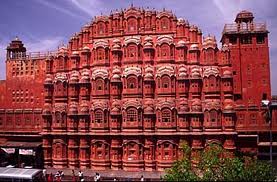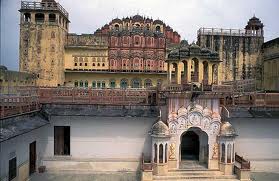Hawa Mahal
Book Now
Hawa Mahal in Jaipur
 Hawa Mahal stands upright as the entrance to the City Palace, Jaipur. An important landmark in the city, Hawa Mahal is an epitome of the Rajputana architecture. The splendid five-storey "Palace of the Winds" is a blend of beauty and splendor much close to Rajasthan's culture. Maharaja Sawai Pratap Singh built Hawa Mahal in 1779. The pyramid shape of this ancient monument is a tourist attraction having 953 small windows. Hawa Mahal stands upright as the entrance to the City Palace, Jaipur. An important landmark in the city, Hawa Mahal is an epitome of the Rajputana architecture. The splendid five-storey "Palace of the Winds" is a blend of beauty and splendor much close to Rajasthan's culture. Maharaja Sawai Pratap Singh built Hawa Mahal in 1779. The pyramid shape of this ancient monument is a tourist attraction having 953 small windows.
History Of Hawa Mahal
Adjacent to the City Palace (where the family of the last Maharaja of Jaipur still lives) is the Hawa Mahal Jaipur,  built by Sawai Pratap Singh and designed by Lalchand Usta in 1799. If you view it from a distance, it looks like a palace with the promise of big, spacious rooms inside. But once you cross the road for a closer inspection, you realise that it is little more than a finely chiselled facade. Out of its five floors, the top three are just a room deep while the lower floors are connected to rooms and courtyards. Hawa Mahal, Jaipur, is an enormous tapering structure with numerous arches, spires and a mind-boggling 953 latticed casements and small windows. If you observe it closely, you'll realise that it is actually a portion of the zenana palace (women's quarters) and what you can view from the road is merely the back of the building. built by Sawai Pratap Singh and designed by Lalchand Usta in 1799. If you view it from a distance, it looks like a palace with the promise of big, spacious rooms inside. But once you cross the road for a closer inspection, you realise that it is little more than a finely chiselled facade. Out of its five floors, the top three are just a room deep while the lower floors are connected to rooms and courtyards. Hawa Mahal, Jaipur, is an enormous tapering structure with numerous arches, spires and a mind-boggling 953 latticed casements and small windows. If you observe it closely, you'll realise that it is actually a portion of the zenana palace (women's quarters) and what you can view from the road is merely the back of the building.
Location oF Hawa Mahal
Palace of winds, also called “specimen of the fanciful architecture” is located on the intersection of Badi Chaupad, south of the city. You have rickshaws, local buses, and autos for communication.
Architecture of Hawa Mahal
 The windows are locally called “jharokas”. You have the tourists peeping in from them to see the beautiful city of Jaipur. These jharokas are integral in allowing the free circulation of air. The same form of style in architecture is seen in the monuments built by the Mughals. The look of the Hawa Mahal, Jaipur resembles a honeycomb with the windows. Looking at “Palace of winds”, you have the feeling of a screen with holes that resembles the moon when lit at night. You begin to appreciate the marvelous structuring and designs that still reflect the glory of the Rajputana. This Mahal adjacent to the City Palace was for the royal women and girls of the palace. Sitting here, they could enjoy the air and have a city view. The windows are locally called “jharokas”. You have the tourists peeping in from them to see the beautiful city of Jaipur. These jharokas are integral in allowing the free circulation of air. The same form of style in architecture is seen in the monuments built by the Mughals. The look of the Hawa Mahal, Jaipur resembles a honeycomb with the windows. Looking at “Palace of winds”, you have the feeling of a screen with holes that resembles the moon when lit at night. You begin to appreciate the marvelous structuring and designs that still reflect the glory of the Rajputana. This Mahal adjacent to the City Palace was for the royal women and girls of the palace. Sitting here, they could enjoy the air and have a city view.
Lal Chand Usta built Hawa Mahal in pink sand stones keeping in mind the pink color of the other monuments in the city. Doomed canopies and the pyramid line of structure resemble that of Rajputana while the floral patterns are that of Mughal. Many tourists find it having a striking similarity with the Fatehpur Sikri. The main attraction in making of the Hawa Mahal is cooling chambers. You can enter the massive building through an imperial door also connecting the City Palace premises. There is also an archaeological museum lodged in here.
Best Time To Go To Hawa Mahal
The royal elegance is still persistent and the monument reminds you that after the restoration work, Hawa Mahal is on the way of getting a facelift. Tourists come here throughout the day and the fun lies in climbing up to view Jaipur through the multiple small windows. Yet, early morning is the best time to go Hawa Mahal. The place is easily accessible by local city buses and rickshaws. The sun gives brings out the original color of the monument facing the eastern side of the royal city gates. The fantastic image that you have conjured up in your mind immediately gets a hint of the true charm of the place.
More Info:
Location: Next to the entrance of City Palace
Highlights: Its Rajputana architecture
How to reach: One can easily reach Hawa Mahal from the city by taking local Buses, Rickshaws and Taxis
|